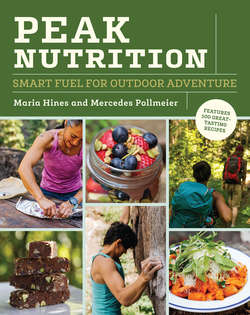Читать книгу Peak Nutrition - Maria Hines - Страница 17
На сайте Литреса книга снята с продажи.
PEAK PROFILE SHAWNTÉ SALABERT
ОглавлениеWHAT IS YOUR GO-TO PERFORMANCE/ENERGY FOOD AND WHY?
On longer hikes or runs, I carry an assortment of energy bites and bars, but nothing can replace the tried-and-true power of Swedish Fish (preferably the large ones, red only). Sure, there’s the quick sugar hit, but it’s really all about the emotional energy boost for me.
BIGGEST CHALLENGE TO GETTING GOOD NUTRITION? ANY EASY SOLUTIONS?
I have a delicate digestive system; too much sugar or caffeine, or any amount of gluten, will set off intestinal fireworks. My solution is to move toward more whole foods and fewer processed ones; it means a heavier carry, but a happy tummy is worth the extra weight.
WHAT IS YOUR BEST EATING HABIT? YOUR WORST?
Best: I eat breakfast every single day; it’s a great way to keep my fire stoked from the jump. Worst: If I buy a bag of chips or a box of cookies, I will annihilate it within one or two sittings. Oh, the guilt! And the indigestion!
HAS YOUR APPROACH TO FOOD, IN RELATION TO PERFORMANCE, CHANGED OVER TIME?
As I partake in more endurance-based physical challenges, I’m learning that not only do I need to vary my “fuel” to include fewer packaged items and more real food energy sources, like sweet potatoes and nut butters, but I also have to eat more frequently so I don’t bonk.
WHAT IS YOUR FAVORITE FOOD INDULGENCE AT THE END OF THE DAY?
Anyone who’s ever backpacked with me knows that for the last few miles of any trip, all I can think about is biting down into a warm, gooey, cheese-stuffed enchilada.
LIGHTNING ROUND: DOGS OR CATS? VAN, SUV, OR TRUCK? DOWN OR FLEECE?
Cat lady for life! Maxine, my slow, but trusty 2005 Honda Civic. Down.
Shawnté Salabert is a Los Angeles–based freelance writer interested in the connections between humans and the natural world. Her work has appeared in Adventure Journal, AFAR, Alpinist, Backpacker, Los Angeles Magazine, Modern Hiker, and Outside, among other outlets. She is also an avid hiker, runner, and author of Hiking the Pacific Crest Trail: Southern California.
This is your back-up anchor because when all else fails, or you feel out of control, you can always come back to it.
Meal frequency. As long as you eat the right foods slowly, and stop when you are 80 percent full, meal frequency is a matter of personal preference and can be mapped to your individual training, eating, and recovery plan for your mountain sport. You could eat smaller meals often or large meals less often. Experiment with what works best for you.
